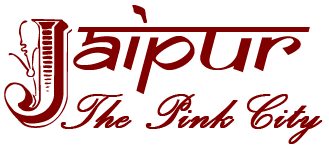

|
Jantar Mantar JaipurDhruva Yantra (The Pole Star Instrument) in Jantar Mantar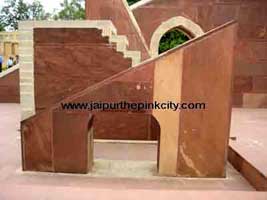
As the name suggests, this instrument is used to locate the Pole star in the sky. It is situated close to the Sun Dial. It is also inclined at 27 degrees and made of red sandstone. This instrument is known as Dhruvadarshak Pattika in Hindi. It is perhaps the simplest of all the instruments found in Jantar Mantar. It is in the form of a small trapezoidal structure whose upper surface point towards the pole star on a clear dark night. The instrument is erected on 3.07 m long and 54 cm wide stone masonry base. Its lower end is about 76 cm above the ground and the upper end is 2.32 m above the ground. This instrument was the compass of an earlier age. Narivalaya Yantra (Equatorial Instrument / Circular Dial) in Jantar Mantar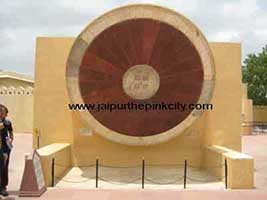
The Nadivalaya has two circular plates, facing North and South which are its dials. The wall of the plates is inclined towards the South at such an angle that the instrument remains parallel to the plane of the Earth's equator. The rods (gnomon) emerging perpendicularly from the plates are parallel to the axis of rotation of the Earth. The shadows of the rods move along the scales on the dial plates, indicating the local time. 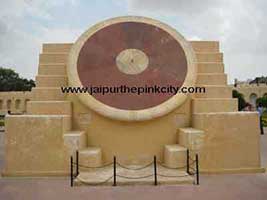
Each dial plate is divided into three circular scales, two of which have markings for the hours and minutes. The third scale is marked for the determination of the "Ghatis" and "Palas" (zenith distance). 1 Ghati equals to 24 minutes and 1 Pal equals to 24 seconds. To the time indicated by the circular scale, a correction factor as displayed for the day at Jantar Mantar, needs to be added to obtain the clock time. The dial plate facing south is sunlit from the autumn equinox to the spring equinox and is to be used for telling the time. The dial plate facing North is sunlit from the spring equinox to the autumn equinox and is to be used for the purpose. These sun dials can also be used for indicating the hemispherical position of heavenly bodies. Yantra Raj in Jantar Mantar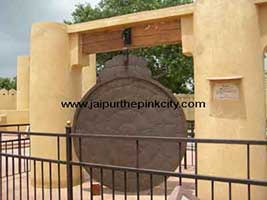
The wide applicability of this instrument can be judged by the fact that the Maharaja wrote two volumes on the Principles and Utility of this huge metal disc of over 2 meters diameter. The hole in the centre is the Pole Star and 27 degrees below is a line representing the latitude of Jaipur. The outer circle is calibrated in 24 hours of 6 fractions each. The inner circle has 360 degrees marking each of 6 sub divisions. The positions of various constellations at different intervals can be calculated by placing a separate disc in the hole at the centre. A number of other astrological calculations can also be done by using this King of Instruments . Brihat Samrat Yantra in Jantar MantarThe functions of this mammoth structure are similar to those of the small sun-dial but the dimensions are ten times more and so is the precision. The base of this right-angled triangle is 44 meters long and the gnomon which makes an angle of 27 degrees rises 27 meters high. There are huge quadrants of 15 meters radius and are calibrated in hours, minutes and seconds. The precision is 2 seconds. 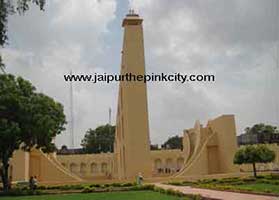
This giant instrument helps to calculate local time, Meridian Pass time, Zenith Distance, Declination and Altitude of the heavenly bodies by the shadow of the gnomon. The calculations can also be made during night time with the help of a thread. This instrument is probably the one most in use today. A number of astrologers gather here on the full moon days of June and July to study the movement and direction of the wind which helps them forecast the rains. For this purpose a thin cloth flag is hoisted at the time of sun-set. If the flag shows easterly breeze, it is an indication of good monsoon and crops. If the wind is southern in direction, the chances of rains are scanty which can result in bad crops and hence famine. Westerly winds evince floods whereas northern wind suggests bounteous crops. Suggested Readings for Jantar Mantar |
||
|
Book Tour for Anywhere Jaipur Tour Explore Jaipur Jaipur Tour Attractions Organize Your Trip Jaipur Practical Info |
Travel With Us
|
You were reading about Jantar Mantar Jaipur.